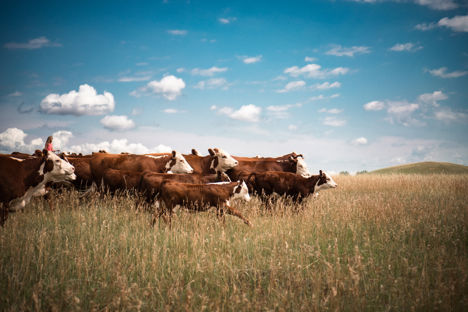
A primer on Prime: a guide to the USDA beef grading system
You've probably seen words like 'prime' used to describe beef before but may not know exactly what that means. We find out more about the USDA grading system, so you know what to be looking out for when buying beef.
A primer on Prime: a guide to the USDA beef grading system
You've probably seen words like 'prime' used to describe beef before but may not know exactly what that means. We find out more about the USDA grading system, so you know what to be looking out for when buying beef.
If you’ve ever read an American recipe for cooking beef, you’ve likely come across a few phrases you didn’t recognise - Prime grade and Choice grade. These terms are very familiar to American shoppers but are somewhat mystifying to British ones. They come from the grading system used by the USDA - United States Department of Agriculture - for different types of meat. Although they can seem a bit confusing at first, these grades are actually very simple and a great way to ensure that you’re buying consistent and high quality meat.
Whether you’re after consistency or impressive marbling, with this guide to the USDA grading system you will be able to navigate your way around buying USA beef in no time.
What is the USDA’s grading system - and why does it exist?
Beef is big business in the United States. It’s an industry that has been entwined with the country’s landscape and identity for generations. If you’re lucky enough to visit the Great Plains, you’ll find that there are still plenty of ranches which haven’t changed much since the 1800s and more than 90% of all ranches are family-owned.
The USDA’s beef grading system was introduced in 1925 to give consumers and buyers a common language, and a guarantee of quality within the huge market that is beef in the USA. Having your beef graded is optional in the USA and is paid for by the meat processor. It certifies that their beef meets certain standards. Meat which displays the USDA beef grading shield is guaranteed by the USDA to be consistent (meet certain requirements for tenderness and marbling).
There are three factors which USDA inspectors look for in beef when grading it: The first is ‘physiological age’. This is related to an animal’s physiological characteristics rather than its actual age, and inspectors will look at the bones and cartilage to work it out.
The second is marbling. Marbling refers to the amount of fat spread throughout the meat, also known as intramuscular fat. This type of fat is what makes beef juicy and tender. A piece of meat with lots of intramuscular fat is streaked with fine white lines of fat in a pattern that makes the meat almost look like a piece of marble, hence the name ‘marbling’. This is different from intermuscular fat, which is the fat on the outside of a piece of meat, such as the rind on a slice of bacon.
Generally, the more marbled a steak is, the more tender it will be. The intramuscular fat renders as the meat cooks, producing a juicy and delicious steak. Most cattle in the USA are ‘finished’ on grain. That is, they spend most of their lives eating grass and then the last 120 days or so eating a balanced diet with grain. This helps the meat become more fatty more quickly than if the cattle grazed on grass their entire life, and produces well-marbled meat.
The final factor inspectors look at is the ‘sex and category’ of the meat - that is whether the meat came from a steer, heifer, cow etc. In the USA most beef comes from young steers and so is very tender.
What do the terms Choice and Prime mean?
Prime and Choice are the two highest USDA classifications of beef and the ones shoppers in the USA are most likely to come across in supermarkets or butchers. They are each suited to different cooking methods.
Prime
Prime beef is the most well-known USDA beef grade outside of the USA. It is the most marbled, fatty USDA grade of beef, and only accounts for 8.9% of all graded beef. Prime beef used to be quite hard for consumers to buy, since it was mostly bought by high-end restaurants and didn’t reach supermarket shelves. However, it’s now much more abundant and easier than ever to purchase. It’s also worth noting that not all prime ribs are graded Prime! ‘Prime rib’ refers to a particular cut of beef ribs, rather than USDA graded Prime beef ribs.
Choice
Choice beef is the most widely available grade of beef in the USA and makes up the majority of all beef graded by the USDA. Although it has slightly less marbling than Prime, it’s still suitable for dry-heat cooking methods like frying, roasting or grilling. There is a very wide range of meat that falls within the Choice category, so there is also a commercial category for beef called ‘high choice’ to help shoppers distinguish between different types.
All USDA grades of beef have their own uses. Once you’re familiar with the two main USDA grades it’s very easy to buy exactly the sort of meat you need. Whether you purchase US Beef graded Prime or Choice, you can have the confidence that you are buying beef with a high level of consistency and reliability.

